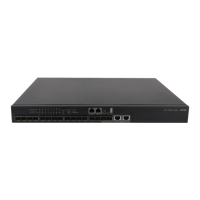39
Planning the cabling scheme
Use the following cables to connect the IRF physical ports on the switch:
• Category 5e or above twisted-pair cable—5G/2.5G/1000BASE-T,
5G/2.5G/1000/100BASE-T, 10G/5G/2.5G/1000BASE-T, and 10G/5G/2.5G/1000/100BASE-T
autosensing Ethernet ports.
• Category 6 or above twisted-pair cable—1/10GBASE-T autosensing Ethernet ports.
• SFP+ transceiver modules and optical fiber or SFP+ cable—SFP+ ports. For the available
models, see SFP+ port in "Appendix C Ports and LEDs."
• SFP28 transceiver modules and optical fiber or SFP28 cable—SFP28 ports. For the
available models, see SFP28 port in "Appendix C Ports and LEDs."
•
QSFP+ transceiver modules and optical fiber or QSFP+ cable—QSFP+ ports. For the
available models, see QSFP+ port in "Appendix C Ports and LEDs."
For a sh
ort-distance IRF connection in an equipment room, use a twisted-pair cable, SFP+ cable,
SFP28 cable, or QSFP+ cable.
For a long-distance IRF connection, use SFP+/SFP28/QSFP+ transceiver modules and optical
fibers.
The following subsections describe several H3C recommended IRF connection schemes by using
SFP+ cables and SFP+ transceiver modules and fibers. All these schemes use a ring topology.
IMPORTANT:
In these schemes, all physical IRF ports are located on the same side. If physical IRF ports are on
different sides, you must measure the distance between them to select an appropriate cable.
Connecting the IRF member switches in one rack
Connect the IRF member switches (9 switches in this example) in a rack as shown in Figure 47. The
switches in the ring topology (see Figure 48) a
re in the same order as connected in the rack.
Figure 47 Connecting the switches in one rack

